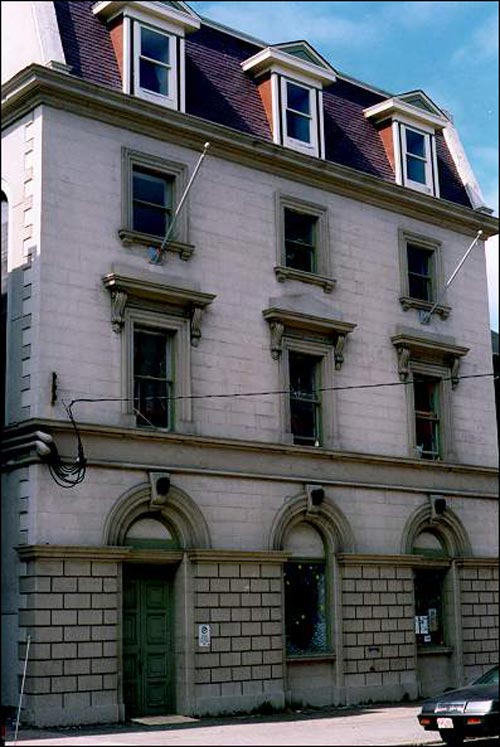Bank of British North America
(276 Duckworth Street, St. John's)
This Italianate-style building was constructed in 1849 to house Newfoundland's first commercial bank, the Bank of British North America (BBNA). The only other banking service available was the government-owned Newfoundland Savings Bank, established in 1836. The impetus for the building of the elaborate BBNA structure was the St. John's fire of 1846 that destroyed the bank's original building. Historians believe the structure to be an early work of well-known Halifax architect David Stirling who designed many Halifax buildings in the 1860s. Stirling is known for the BBNA's building in Halifax and later churches in the Gothic Revival style.

Formed in 1835, the Bank of British North America established its first colonial branch in Newfoundland in 1837. Subsequently, other branches were opened in New Brunswick, Nova Scotia, British Columbia, the Yukon and in California. In Newfoundland the BBNA faced stiff competition from the rival Union Bank, formed in 1854, and was forced out of business in 1857. The newly formed Commercial Bank of Newfoundland purchased and operated out of the building from 1857 to 1894. It was during the occupancy of the Commercial Bank in 1885 that a mansard roof was installed to replace the hipped roof providing extra space.
It was also during this second phase of ownership that the building received considerable damage from the Great Fire that ravaged much of the city in 1892. The building itself was one of the few structures to survive the devastation, although the interior sustained considerable damage and was reconstructed, most likely based upon the plans of well-known Newfoundland architect William Howe Greene. Greene is known for his work on the Supreme Court House and Cabot Tower. The top three floors were elaborate living quarters for the resident bank manager.
On December 10, 1894 a watershed event in Newfoundland's history occurred - the closure of the main banks in the colony, the Commercial and the Union. It ushered in the era of large Canadian Banks being involved in Newfoundland's affairs. The banknotes issued by the Commercial and Union banks were Newfoundland's only currency and consequently their demise left the colony destitute. Canadian banks rushed to Newfoundland's assistance and began to establish branches in the colony. The Bank of Montreal made the greatest contribution by lending the Newfoundland government sufficient funds to meet interest payments and for a resumption of the construction of the railway. In addition, they lent sufficient funds to allow a local merchant firm to buy fish from distressed fishermen. By 1897 the Bank of Montreal exclusively controlled the Newfoundland government's accounts. This led to the establishment of Canadian currency as legal tender within Newfoundland and the local currency being made compatible with that of the Dominion of Canada.
Befitting the new era in Newfoundland's economic history, in 1895 the Bank of Montreal moved into the building constructed for the first commercial bank in the colony, the BBNA. Two years later, the only Newfoundland bank to survive the 1894 Crash, the Newfoundland Savings Bank, moved into the building and ran its operations from there for 65 years. The Savings Bank was an important tool that the Newfoundland government used to raise money for the war effort from 1914-1918 via a savings stamp plan that involved thousands of school children. In 1962 the Bank of Montreal purchased the Savings Bank and reacquired the building.
The Bank of Montreal sustained a branch in the building until 1985 when it donated the building to the City of St. John's. At present the building is home to the College of the North Atlantic's Anna Templeton Centre. Anna Templeton had a life long involvement in the local arts and crafts scene, including a period in the 1960s when she was supervisor of the Craft Training Division of the Department of Education. The centre was established in her honour as a non-profit crafts and arts training and education centre, where courses are offered in weaving, knitting, print and dye techniques, as well as surface embellishment and photography.
In recognition of the importance of the Bank of British North America's building to Newfoundland's banking history, the Heritage Foundation of Newfoundland and Labrador designated the site a Registered Heritage Structure on May 3, 1991. This structure was also awarded the Southcott Award for heritage restoration by the Newfoundland Historic Trust.
Also view the Bank of British North America Registered Heritage Structure, and the Anna Templeton Centre (former Bank of British North America) - City of St. John's Heritage Site on the Heritage Foundation of Newfoundland and Labrador web site. The Newfoundland and Labrador Heritage Web Site has on its site only a portion of the registered heritage structures in Newfoundland and Labrador. To view a complete list or search for a particular structure visit the Heritage Foundation's Property Search page.




